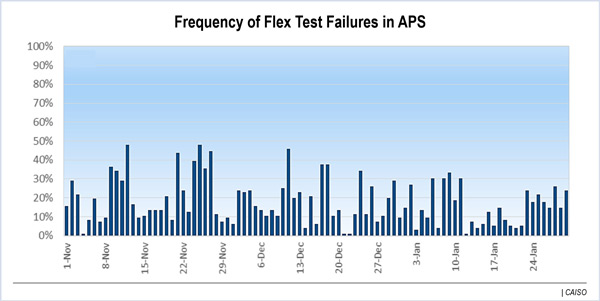By Robert Mullin
Participants in the Western Energy Imbalance Market (EIM) should not rely on it to reduce their capacity requirements, a CAISO official cautioned last week.
Mark Rothleder, CAISO’s vice president for market quality and renewable integration, made the comment when probed on the issue during a Feb. 1 meeting of the EIM’s governing body.
Rothleder shared his views in response to a question by Dan Williams, CAISO markets analyst with Portland General Electric, which is slated to join the market in October. “We often hear about the interplay between planning capacity — to be able to stand alone as an EIM entity or as a balancing authority — versus what happens in real time in the optimization benefits that we get,” Williams said.
Williams wanted to learn more about how the EIM influences how existing participants view their long-term flexible resource needs as a model “for how the rest of us are starting to look at that as well.” “Flexible” resources are those equipped to respond to variability on the grid stemming from the uneven output of renewable generation.
Rothleder said the question comes up during the ISO’s own resource adequacy process at the California Public Utilities Commission: How does a utility value flexible capacity at the interties to the balancing authority area (BAA) and, more generally, from the EIM?
EIM’s Design
The answer lies in understanding how the EIM was designed and what it is intended to do, Rothleder said.
First: It’s a voluntary market.
Second: The market is built on the idea that each participant maintains responsibility for its own BAA, unlike in a full RTO.
“You put those two things together and I think you get to the point where the balancing area, in order to maintain their reliability, can’t rely on EIM to avoid capacity upgrades that they may need to meet their [integrated resource plan], resource adequacy or flexible capacity needs,” Rothleder said.
Any participant that leans too heavily on the market for reliability needs puts itself at risk because the market is oriented toward short-term resource sufficiency. The market penalizes those participants that come into an hour short of resources.
“If you fail those [short-term sufficiency] tests, you basically are isolated and you stand alone, and at that point you have to rely on your own flexibility and capacity,” Rothleder said. “You are not able to rely on the rest of the Energy Imbalance Market.”
The EIM is designed to ensure that participants come into the market with adequate resources while benefiting from the economic efficiencies of intra-hour dispatch. “But you don’t necessarily get the benefit of avoiding long-term capacity,” Rothleder said.
EIM vs. ISO
That’s the difference between the EIM and full participation in the ISO. “Under full participation, those types of issues — long-term capacity, long-term resource adequacy — become subsumed under the umbrella of the footprint of the integrated balancing area,” Rothleder said. “Then you can deal with those things.”
Rothleder pointed out that studies quantifying the benefits of the EIM have addressed only short-term efficiency, not long-term capacity.
EIM governing body member Doug Howe pressed Rothleder on the issue. “You said the benefits of EIM don’t include the value of avoided capacity costs, but that’s not to say that there isn’t avoided capacity costs in the EIM,” Howe said. “Am I correct?”
Rothleder responded that getting credit for EIM-based capacity would come down to a “judgment call” between the participant and its state utility commission. And he also pointed to the risks of taking that approach.
“Do you now avoid getting flexible capacity in the area and setting up your own sufficiency?” Rothleder said. “Because if you do that, you run the increased risk of coming in short. And if you’re short, you’ve got to be able to manage those variabilities on your own.”
Governing body member Carl Linvill pointed out that EIM members have touted the market’s contribution to improving their own knowledge of their systems and ability to optimize processes. “It seems to me that speaks to some flexibility benefit associated with onboarding” with the EIM, Linvill said.
The improvements associated with transitioning from manual to the EIM’s automated dispatch would still be considered short-term benefits, Rothleder said.
Linvill asked whether EIM members could reduce their reserve margins after participating in the market over a period of time.
Reserve margins are generally tied to peak load, which doesn’t change with the EIM, Rothleder said.
“Can they factor in other things? Potentially,” he added. “But I think that becomes a real judgement call to rely on the EIM, so I can’t speak to that.”
CAISO CEO Steve Berberich said the issue pointed to the limitations of the EIM.
“This is one of the benefits of a fully integrated market: You get capacity benefits,” Berberich said. “You don’t get capacity benefits in the Energy Imbalance Market — and I’ll just leave it at that.”




